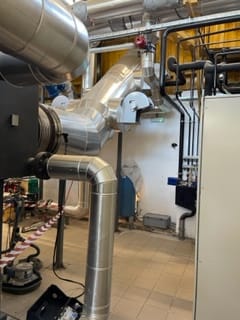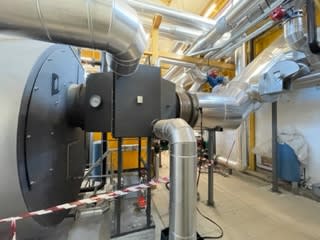Hello guys, i need some help. We installed a three-pass 6 MW hot water boiler 90/70°C with an economizer and a combined low NOx natural gas burner (class III.) and light gasoil (class II.) . The economizer shakes and vibrates during operation. No particularly loud noise. It vibrates towards the chimney and back towards the smoke chamber of the boiler. The economizer is fixed to the boiler with a flange, behind the economizer there is a compensator, which connects it to a 5 m long flue pipe with a 40° slope towards the chimney. The chimney is 20m high. The vibration occurs over the entire working field of the burner from 20% to 100% and increases linearly. The vibration is similar when using either of the two fuels. The vibration acts as a pulse, and when observing the gas pressure gauge (when burning with natural gas), a visible movement of the pointer in the area of 5-7% of the scale is consistent with the vibration. The burner in the front does not shake and neither does the boiler in the front. The vibration seems to be happening between the smoke chamber and the economizer inlet. The flue connection does not vibrate as the economizer is connected to the compensator. It looks like the economizer is stretching and contracting. We additionally reinforced the smoke chamber internally and reinforced the base of the economizer, but without any effect on vibrations. Burner combustion appears normal, NOx emissions are relatively low (NOx gas 80 and oil about 150), and oxygen is constant. The chimney was recalculated twice and the result was positive. Three draft regulators are built into the flue pipe towards the chimney; we performed a test with closed and open but it has no effect on vibrations/pulsations. However, the smoke draft is more stable with closed draft regulators. Does anyone have an idea how to tackle the issue and determine the cause?
Video links:






Video links:






